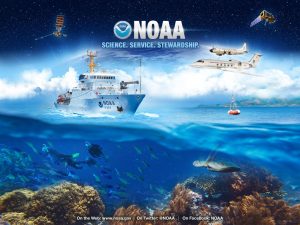Help from above – using planes, drones, and satellites to study and protect plants and animals **Smithsonian National Air and Space Museum NOAA Family Day**
NOAA Live! All Stars:
Katie Sweeney, NOAA’s Alaska Fisheries Science Center in Seattle, WA
Allison Henry, NOAA’s Northeast Fisheries Science Center in Woods Hole, MA
Brandon Krumwiede, NOAA’s Office for Coastal Management in Duluth, MN
Jennifer Stock, NOAA’s Cordell Bank National Marine Sanctuary in Point Reyes, CA
In partnership with the Smithsonian National Air and Space Museum. This webinar features NOAA experts discussing the ways NOAA aircraft, satellite tracking, and drone technology help us understand marine species and support conservation efforts along our ocean and coasts. How do we use drones to observe northern fur seals, airplanes to identify and count endangered North Atlantic right whales, aerial imagery to manage manoomin (wild rice), and satellite tags to follow seabirds? Learn about the unique tools we use to collect high-quality environmental data to better understand these important species and aid in conservation efforts.
Resources to access at home:
» Soar Together @ Air and Space NOAA Family Day event page: This has links to other live events and fun activities to do with your family
» Arctic UAV’s Game App: Up for a hands-on game challenge? Navigate a flying quadcopter during stormy Alaska weather, catch the perfect aerial shot of rare wildlife, and uncover trails through rough sea ice, all in this mobile app game, Arctic UAVs
» NOAA right whale id matching game- Can you identify the right whales by their callosity? Try it out with these: match the animal cards and answer key
» Seabird and Shorebird Activity Book– The Hawaiian Islands Humpback Whale National Marine Sanctuary put together this fun book. Seabirds secret code, shorebirds word find, seabirds mobile, and more!
» Do a virtual Albatross Bolus dissection– Albatross throw up what they can’t digest. Measure and count natural and non-natural items in this virtual bolus dissection activity.
» Fur seals on Bogoslof Island: Post 4- Evolving Science on an Evolving Island – Katie’s team tested two camera systems on drones on Bogoslof Island in Alaska in September 2019
» New Drone Technology Could Revolutionize Marine Mammal Monitoring
» Association for Unmanned Vehicle Systems International – Student Unmanned Aerial Systems Competition
» Examples of using Unmanned Aerial Systems in NOAA research – NOAA Unmanned Aerial Systems Program
» North Atlantic right whale catalog: The catalog contains all the photographed sightings of right whales from the North Atlantic.
» Stellwagen Bank National Marine Sanctuary Shearwater Tagging Project
» Efforts to Restore Native Wild Rice in the St. Louis River Estuary
» Makani: The albatross that cares for the land: An interactive activity/story book about a Laysan Albatross (pdf download)
» Telepresence technology uses a high-bandwidth satellite connection to allow anyone with an Internet connection to virtually participate in ocean research and exploration expeditions. Join one here and learn more about telepresence here.
Videos
- PBS Wisconsin Education video: This ~4-minute video follows Fred Ackley Jr. from the Sokaogon Chippewa Community of Mole Lake as he harvests and processes manoomin, or wild rice.
- Mapping the Invisible: Introduction to Spectral Remote Sensing: NEON Science video overview of spectral imagery and its use to identify differences between different parts of the electromagnetic spectrum
- Investigating Steller Sea Lion Populations: Join scientists on a research vessel to western Aleutian Islands—closer to Russia than mainland Alaska. Here, they investigate what’s going on with endangered Steller sea lions, some populations of which are declining, while others are thriving
- Henry Wood Elliott: Defender of the Fur Seal: In the twenty years following the United States’ acquisition of the Alaska territory (1867), revenues from the Pribilof Island fur seal harvest paid off the 7.2 million dollar purchase price. This documentary uncovers this little-known piece of American history told through the story of Henry Wood Elliot
- Northern Fur Seal Migrations: Every year, northern fur seals migrate 6,000 miles round-trip from their summer breeding grounds on the Pribilof Islands in the Bering Sea. Learn about the scientists at NOAA who are tracking these seals on their incredible migrations, and where the seals go during the winter
- B-Roll: Northern Fur Seal Research on Bogoslof Island: Select footage of northern fur seal research on Bogoslof Island, an active volcano that erupted from December 2016 – August 2017. This footage was taken August 12-16, 2019, along with some reference match frames that were filmed on July 12, 2005
- NOAA Ocean Today Endangered Ocean: There are several short videos on topics ranging from the endangered species act, manatees, North Atlantic right whales, and more.
- Watch A Perfect Day for an Albatross and Other Seabird Tales, a book reading of Caren Loebel-Fried’s childrens book with special highlights shared from her trip to the Albatross breeding colony on Midway Atoll National Wildlife Refuge and seabird highlights from the Papahanaumokuakea Marine National Monument, a UNESCO World Heritage Site and Cordell Bank National Marine Sanctuary.
- “This is NOAA” video (~3 min): This video describes NOAA’s role as a global leader in environmental science and technology, working to address our Nation’s most pressing challenges and advance our mission of science, service, and stewardship
Previous NOAA Live! Webinars by these experts
- A Bird’s Eye View of Whales with Allison Henry
- Flying Beneath the Clouds at the Edge of the World with Katie Sweeney
- Winged Ambassadors: Ocean Travelers with Jennifer Stock
- Drones, Scat, and the Joys of Marine Mammal Fieldwork in Alaska with Katie Sweeney
- Fresh Coast: Where Food Grows on the Water with Brandon Krumwiede

